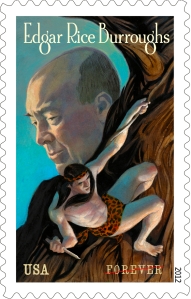 Edgar Rice Burroughs, one of the most popular and prolific authors of the early 20th century, was born in Chicago on this day in 1875. Burroughs is best known as the inventor of Tarzan, but here are five other things we bet you didn’t know about him:
Edgar Rice Burroughs, one of the most popular and prolific authors of the early 20th century, was born in Chicago on this day in 1875. Burroughs is best known as the inventor of Tarzan, but here are five other things we bet you didn’t know about him:
Burroughs attended Michigan Military Academy, where he briefly taught geology after graduation. Afterward, he joined the Army, serving in the Arizona Territory with the U.S. Cavalry until being honorably discharged in 1897 for health reasons.
Burroughs held a wide range of jobs: He ran a stationery store, dredged for gold, and worked as a railroad policeman and door-to-door book salesman. He also unsuccessfully sought a commission in the Chinese army.
While working as a manager for a pencil-sharpener company, Burroughs wrote and sold his first short story, “Under the Moons of Mars,” in which a Confederate Civil War veteran named John Carter is mysteriously transported to Mars—known to locals as Barsoom—and meets a princess named Dejah Thoris. “Under the Moons of Mars” was serialized in All-Story magazine in 1912 under the pseudonym “Norman Bean.”
Burroughs soon began writing a book about a British child raised by apes in Africa. At first, he struggled to find a name for the character, considering both “Zantar” and “Tublat-Zan” before finding inspiration in “Tarzan.”
This collectible package includes a sheet of 20 stamps and an envelope with the First Day of Issue color postmark. Click the image for details.
Burroughs’s Mars books are credited with popularizing what is now known as “planetary romance,” a highly popular genre that flourished in pulp magazines from the 1920s until World War II. Combining futuristic technology with anachronistic, feudal settings, these swashbuckling outer-space adventures inspired generations of science fiction writers and filmmakers. John Carter, a film adaptation of the Mars series, was released in 2012.
In 1973, the Burroughs crater on Mars was named in his honor. He would have loved it. “If there is a hereafter,” he once said, “I want to travel through space to visit other planets.”
The Edgar Rice Burroughs Forever® stamp was issued in 2012 to coincide with the 100th anniversary of the publication of Burroughs’s first story, “Under the Moons of Mars,” and his first Tarzan story, “Tarzan of the Apes,” in 1912. It is currently available online and by calling ().


 To evoke the look of Civil War-era broadsides, Emancipation Proclamation stamp art director Antonio Alcalá and
To evoke the look of Civil War-era broadsides, Emancipation Proclamation stamp art director Antonio Alcalá and 

